![]()
![]()
![]()
Use LEFT and RIGHT arrow keys to navigate between flashcards;
Use UP and DOWN arrow keys to flip the card;
H to show hint;
A reads text to speech;
65 Cards in this Set
- Front
- Back
|
Yield strength |
Measures a materials strength. Materials with large yield strength are harder to deform. When metals deform they get stronger. |
|
|
Elastic |
Elasticity refers to the material's ability to deform in a non-permanent way, meaning that when the stress load is removed from the material it will recover its original form. A material will continue to deform elastically as the stress upon it increases until the elastic limit is reached. |
|
|
Plasticity |
plasticity describes the deformation of a (solid) material undergoing non-reversible changes of shape in response to applied forces. For example, a solid piece of metal being bent or pounded into a new shape displays plasticity as permanent changes occur within the material itself. |
|
|
Ductility |
Amount a material stretches before it breaks. |
|
|
Tensile strength |
The limit beyond which the material fails. |
|
|
Necking |
is a mode of tensile deformation where relatively large amounts of strain localize disproportionately in a small region of the material. The resulting prominent decrease in local cross-sectional area provides the basis for the name "neck |
|
|
True stress |
True stress is the applied load divided by the actual cross-sectional area (the changing area with respect to time) of the specimen at that load. Engineering strain is the amount that a material deforms per unit length in a tensile test. Also known as nominal strain. |
|
|
Toughness |
the ability of a material to absorb energy and plastically deform without fracturing |
|
|
Compressive strength - ceramics |
Ddfg |
|
|
Hardness |
Resistance of metal to plastic deformation, usually by indentation. However, the term may also refer to stiffness or temper, or to resistance to scratching, abrasion, or cutting. |
|
|
Yield Strain |
Ghuj |
|
|
Solution hardening |
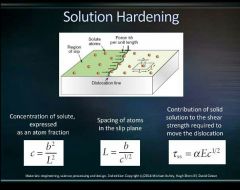
Solid solution hardening is strengthening by deliberate additions of impurities or, more properly said by alloying. Alloying elements are generally bigger than those of the host material, making it harder for dislocations to move |
|
|
Vacancies |

A location in a crystal lattice where an atom is missing |
|
|
Substitutional solute atoms |
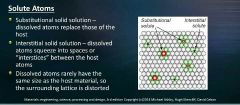
A point defect in which an impurity atom substitutes for a host atom |
|
|
Interstitial solute atoms |

A 0D point defects where a smaller atom fits in between other atoms in a crystal lattice |
|
|
Grain boundaries |

A planar defect that is the 2D interface between adjacent grains (single crystals) in a polycrystalline material |
|
|
Grains |
Ejde |
|
|
0D (point defects) |
Any defect that affects a few neighboring atoms or lattice points |
|
|
1D (line defects) |
The edge of a distorted plane of atoms in a lattice |
|
|
2D (planar) defects |
The interface between adjacent grains in a lattice |
|
|
Edge dislocation |
A 1D defect that is the edge of an extra half plane of atoms within a crystal lattice |
|
|
Screw dislocation |
1D line defect in which a path spirals around a dislocation line penetrating though otherwise individual parallel planes |
|
|
Interstices |
Ejeje |
|
|
Dislocation |

|
|
|
Shear Force |
Jejs |
|
|
Slip planes |
Djeje |
|
|
Burgers vector |
The displacement vector that "close the loop" when traversing an equal number of lattice steps around the defect |
|
|
Dissolve |
D |
|
|
Solid solution hardening |
uses individual atoms distributed in the lattice to impede dislocation motion. Both substitutional and interstitial solute atoms perturb the atomic bonds in the lattice around them, “roughening” the slip plane, i.e. making it more difficult for the atomic bonding defect around a dislocation to move over the slip plane at this point. |
|
|
Interstitial solid solution |
J |
|
|
Impurities |
R |
|
|
Alloying |
S |
|
|
Hume-Rothery rules for solubility |
G |
|
|
Electronegativity |
G |
|
|
Valency |
Dg |
|
|
Dispersion strengthening |
A more effective way to impede dislocation is to disperse small, strong particles in their path. Disperse small solid particles of a high melting point compound into a liquid metal and to cast it to shape, trapping the particles in place. |
|
|
Precipitate strengthening |
If a solute is dissolved in a metal at high temperature when both are molten, and the alloy is solidified and cooled to room temperature, the solute precipitates as small particles. |
|
|
Work hardening |
uses plastic deformation to increase the dislocation density. Dislocations obstruct one another’s movement where they intersect, increasing the yield stress. |
|
|
Grain boundary hardening |
U |
|
|
Annealing |
Hro |
|
|
Hardening = strengthening |

|
|
|
Solution hardening |
Rs |
|
|
Dispersion hardening |
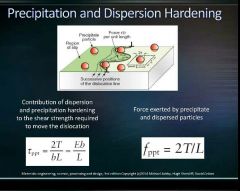
Disperse small, strong particles into a liquid metal, trapping the particles when it is cast in to shape. |
|
|
Precipitate hardening |
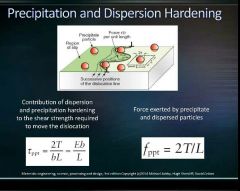
Solute dissolved in a metal while both are molten; precipitates as small particles when cooled |
|
|
Work hardening |

Caused by the accumulation of dislocations generated by plastic deformation. Dislocation density is defined as the length of dislocation line per unit volume. |
|
|
Grain boundary hardening |
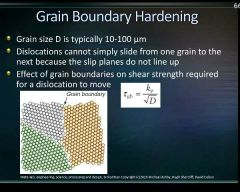
|
|
|
Annealing |
Lj |
|
|
Dissolve (solution hardening) |
Dhd |
|
|
Substitutional sold solution (solution hardening) |
Dhd |
|
|
Interstitial solid solution (solution hardening) |
Hshs |
|
|
Impurities (solution hardening) |
Hsns |
|
|
Alloying (solution hardening) |
Hshs |
|
|
Zn+Cu= Brass (solution hardening) |
Brass uses strong solid-solution hardening, with the high levels of Zn added to the Cu. As the material is cast, no work hardening is used in this case (but brass is often “wrought”, i.e. shaped by deformation, and thus work hardened). |
|
|
Cu+Sn= Bronze (solution hardening) |
Hsjs |
|
|
Stainless steels (solution hardening) |
Dhd |
|
|
Hume-Rothery rules for solubility (solution hardening) |
Dhs |
|
|
Electronegativity (solution hardening) |
Ehe |
|
|
Valency (solution hardening) |
Ehe |
|
|
Al+SiC (dispersion hardening) |
Eje |
|
|
Al+Cu (precipitate hardening) |
Hsh |
|
|
Cu+Be (precipitate hardening) |
Ehe |
|
|
Rolling (Work hardening) |
Hee |
|
|
Bending (work hardening) |
Whe |
|
|
Shearing (work hardening) |
Jes |
|
|
Drawing (work hardening) |
Dhd |

